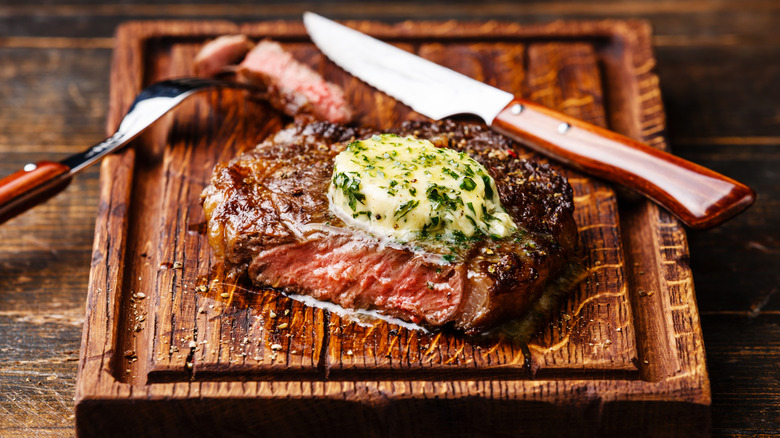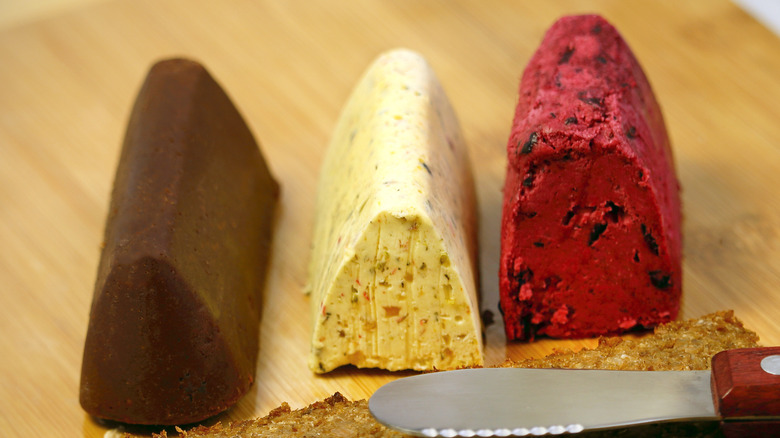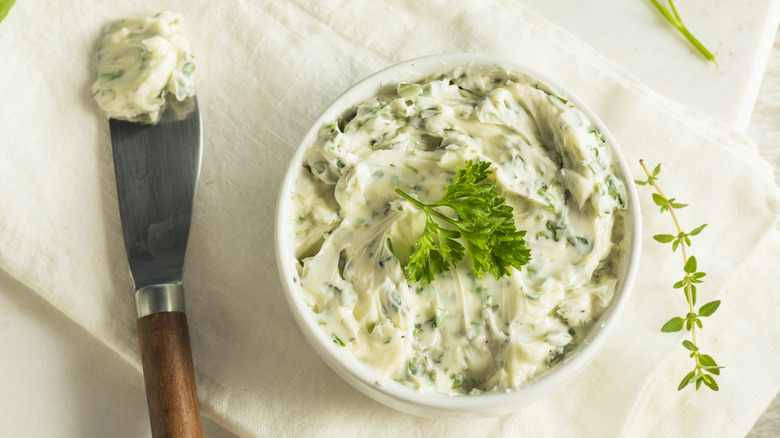The Easy Formula To Build Your Own Compound Butter For Steak
The best restaurants finish their steak in butter. You've likely seen clips of a sizzling steak getting basted in that melted liquid gold with herbs and garlic, but you can also serve your steak with a pat of butter on top. Since it's there to flavor your beef, opting for compound butter (butter with delicious stuff in it) is the key unlocking serious flavor.
Making compound butter is incredibly easy, and the formula is just as simple to remember: Around a tablespoon or 2 of your preferred flavorings for every stick of butter. Alton Brown's version of compound butter from his show "Good Eats: Reloaded" features two sticks of softened butter and 2 tablespoons of herbs. What do you like with your steak? Garlic and herbs, blue cheese, mushrooms, caramelized onions, or an Argentinian chimichurri, perhaps? All of these can be turned into compound butter.
Soften the butter, but don't allow it to melt. Add it to the bowl of a stand mixer and whip it until it becomes light and fluffy, and then mix in your flavorings. Once combined, roll into a log wrapped in parchment paper or store in a sealed container in the fridge.
What can you add to compound butter?
The most classic version of compound butter simply uses fresh herbs, traditionally parsley, and lemon juice or zest. Beef will also benefit from rosemary, thyme, or tarragon, but nearly anything that takes steak to another level can be made into a compound butter. A butter made of parsley, cilantro, and chiles blended in a food processor with red wine vinegar can add a zippy freshness to cut through the fatty richness of the steak, for example. Can't enjoy your favorite char-grilled cut without a splash of steak sauce? Splash some into the softened dairy product to mellow its tanginess with the butter's creamy richness. Speaking of dairy, any cheese can be blended with butter, from blue to Brie.
Compound butter isn't only great with steak, of course. You can make an Old Bay compound butter for seafood or go simple with garlic, lemon, and a medley of herbs. Use orange zest, cranberries, and sage for a roast turkey dinner — spread softened compound butter under the skin of the bird for extra depth of flavor. Finish pasta with a pesto compound butter or, for something really earthy and decadent, use truffles. If you have local, seasonal access to them, stretch precious ramps by folding them into a mound of the churned stuff. Make honey lavender compound butter or cinnamon honey butter for rich breads, rolls, and biscuits. You can let your imagination run wild, as long as it follows some general guidelines.
Rules for making compound butter
Butter should be at the right temperature when you start your compounding. Butter loses its plasticity at 50 degrees Fahrenheit and becomes brittle, and it melts above 90 degrees. To keep it from melting while you're mixing, aim to hold it above 60 but below 75 degrees Fahrenheit. This will allow it to whip, which helps it to combine evenly with the flavorings.
It may be tempting to add more flavorings to your compound butter, but it's best to stick to the formula. In this case, more is not necessarily more. After all, you're not making butter-coated mix-ins, you're making seasoned butter. Adding a cup of parsley to one stick of butter, for example, will just give you a really weird tabbouleh.
Butter is an emulsion — fat wrapped around water molecules — but you can't emulsify more liquid into it; added liquids won't absorb into the fat. They may disperse, but you'll never get a perfect emulsion when adding too much moisture to your softened butter, no matter how well you mix it. If you add too much, a number of bad things could happen: It may not combine at all, it may weep as it sets, it may not set, or it may separate as it sets. To avoid catastrophe, limit the liquid you add to 1 tablespoon per stick of butter, maximum.


